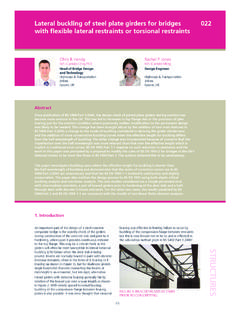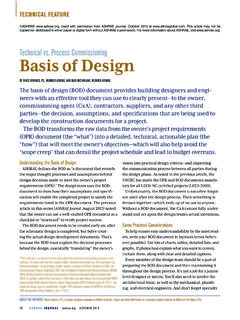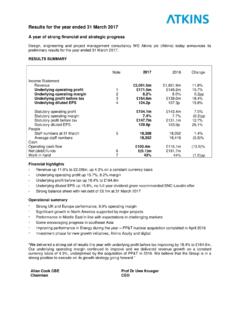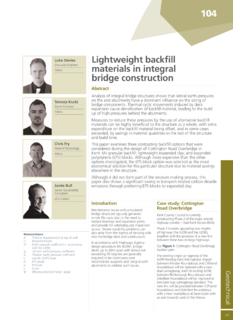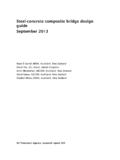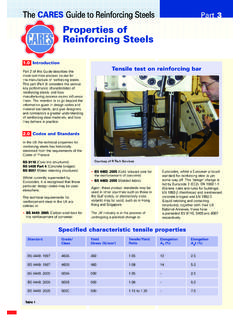Transcription of 90 bridge design charts for Eurocodes - Home – …
1 STRUCTURES75 Abstract90 Preliminary steel concrete composite bridge design charts for EurocodesHighways & TransportationAtkinsSenior EngineerHighways & TransportationAtkinsThe British Constructional Steelwork AssociationRegional Head of bridge EngineeringTechnical Development ManagerDavid A Smith Chris Dolling Rachel Jones Project backgroundThe structural eurocode program started in 1975 with the aim of removing technical barriers to trade in the European Union. The eurocode parts and UK National Annexes required for bridge design have now all been published. Projects tendered after March 2010 under the EU Public Procurement Directive are required to use the Structural Eurocodes . A consequence of the change is that a large proportion of guidance and software currently available needs to be revised. This provides an opportunity to improve on existing design tools and enable more effi cient designs. As part of the transition to the Eurocodes , Corus, the British Constructional Steelwork Association (BCSA) and the Steel Construction Institute (SCI) have revised the guidance they publish for bridge guidance includes a set of charts that can be used to establish the plate girder sizes for steel-concrete composite bridges7.
2 These can be used at the preliminary design stage to establish approximate steel quantities and to obtain initial sizing for design iteration. The original charts allow the user to obtain top and bottom fl ange areas and the web thickness for steel-concrete composite bridges designed to BS 5400 Part 51 using highways loading to the DMRB standard BD37 paper describes the commission to revise these charts for design to the Eurocodes . The new charts are intended to complement the new versions of the SCI composite highway bridge design guides and it was ensured that the design practice used for the charts aligned with that given in the SCI publications. The updating of the charts provided an opportunity to extend their scope and accuracy and enhance their presentation with an electronic format which allows instant interpolation. Scope of the design chartsThe new charts allow for the preliminary design of multi girder bridges with any number of main beams (Figure 1) and ladder deck bridges with two main beams and regularly spaced cross girders (Figure 2).
3 The scope of the new charts was established so that they cover most standard UK highway bridges. Table 1 summarises the scope of the charts . Both simply-supported and continuous spans are included in the charts . For continuous spans a separate girder section is given at the support and at midspan. A difference from the original charts , for multi girder bridges is that separate designs have been established for the outer girder supporting the parapet outstand and for the inner girders. The designer can select from two different highway live loading types. Load Model 1 in BS EN 19913 roughly corresponds with the HA only loading from BD37/01 and Load Model 3 is similar to HA and HB loading switch to Eurocodes from April 2010 required the development and updating of many existing design tools. For many years Corus, and British Steel before them, have published preliminary design charts for steel-concrete composite highway bridges as part of their suite of design guidance for bridge engineers.
4 These charts were originally developed using BS 5400 and the Highways Agency s design Manual for Roads and Bridges (DMRB). This paper describes the development of a new set of charts based on the structural Eurocodes . The new charts take advantage of benefi ts in effi ciency permitted by the Eurocodes and also extend the scope of the original charts . The process adopted to generate the data for the charts is described and the key differences between the BS 5400 design approach and the eurocode approach are discussed. 7506/06/2011 13:59:49 STRUCTURES7690 Preliminary steel concrete composite bridge design charts for EurocodesThe grillages were generated using the fi nite element package LUSAS9 which allows the use of visual basic scripting. A script was written which extracted the key dimensions and section properties of each grillage from a defi ning Excel spreadsheet and used these dimensions to create an appropriate grillage. This is worked in a similar manner to LUSAS s built in grillage wizard.
5 The bespoke script then applied the loading, ran the analysis of the model and extracted the analysis results back into a spreadsheet. This process allowed a large number of similar grillages to be set up and analysed in turn with minimal user intervention. There were a number of assumptions about typical designs that needed to be made for all the grillage models. Typical dimensions for the slab concrete and reinforcement, surfacing and parapet edge beam were selected with reference to the SCI design examples. For the ladder deck bridges appropriate sizing for the crossbeam was established for different cross girder and main girder spacing ranges and these typical values were used in the grillage models. The details of these assumptions are provided with the fi nal charts and summarised in Table the multi girder bridges the charts cover bridges with any number of multi girders. The results for the charts were extracted for one of the outer girders and the adjacent girder (see Figure 4).
6 The grillage models were all set up with six main girders. This provided suffi cient deck width for the effects of the parapet edge beam on the remote inner girders to be small. The charts give both elastic (non-compact) and plastic (compact) designs for all situations. For each individual bridge either an elastic or plastic design will be more effi cient, this choice is left to the designer s discretion. An advantage of including both designs for all situations is that it allows interpolation between discrete values on the charts , which would be prevented by having a discontinuity at the point where either the elastic or plastic design becomes more effi the charts - analysisGrillage modelsThe original charts were derived using line beam analysis. To more accurately include the benefi ts of transverse distribution, the new charts are based on the results of a series of grillage analyses. The data for the charts was generated from a large number of grillage models.
7 Figure 3 shows a typical model. Setting these up manually would have been extremely time consuming and so the process was automated. Figure 1 - Multi girder bridge - typical cross sectionFigure 2 - Ladder deck bridge - typical cross sectionFigure 3 - Typical grillage modelFigure 4 - Girders used for generating 7606/06/2011 14:00:16 STRUCTURES7790 Preliminary steel concrete composite bridge design charts for EurocodesLive loadingLive loading was applied in accordance with BS EN 19902 and BS EN 1991-23 and the corresponding UK National Annexes. It was assumed that traffi c loading would control the design and so this was factored as the leading variable action with other variable actions factored as combination effects in accordance with BS EN 1990. Combination factors and partial factors for each action were taken from Annex A2 of BS EN two live loading cases provided in the charts are Load Model 1 and Load Model 3 (see Figure 5). Load Model 1 includes a uniformly distributed load (UDL) across the whole carriageway and tandem systems (TS) of different magnitudes applied to three lanes.
8 The UK National Annex values calibrate the UDL to correspond approximately to BD37/01 HA loading. Load Model 3 includes, in addition to the UDL and tandem systems, a Special Vehicle (SV) and so is similar to HA with HB loading in BD 37/01. There is a variety of special vehicles detailed in the UK National Annex to EN 1991-2. SV196 (shown in Figure 6) was used for generating the charts as this most closely corresponds to the magnitude of HB loading to BD37/01 used for trunk the time the charts were produced a suitable commercial automatic load generation tool for eurocode live loading was not yet available. The most adverse live loading arrangement is most effi ciently established using infl uence surfaces. However, this method would have required a complex automation process to be developed. Instead, the live loading was generated by applying loading at all possible positions and enveloping the results to obtain the worst effects at specifi c locations. This increased the computational time and fi le sizes, but was considerably simpler to automate.
9 If the UK National Annex is followed the magnitude of the eurocode UDL is independent of loaded length and constant for all lanes and so this simplifi ed approach was easier to adopt than it would have been with BD37/01 loading. The eurocode does give scope for different UDLs in different lanes but this was avoided in the calibration of the UK National Annex. Continuous spansIn order to obtain designs for hogging and sagging regions of continuous spans a basic span layout needed to be assumed. The arrangement used was a three span structure with end spans 70% the length of the central span. The section design at the pier support location was based on the load effects over the pier and the sagging spans section design was based on the load effects at midspan of the central span and the splice location between the two section types (see Figure 7). This arrangement gave reliable results for continuous bridges where the span Multi GirderLadder deckMain girder 4m5m 20mSpan15m 60m15m 60mSpan to Depth Ratio20 3020 30 Cross girder spacingN/A3m 4mKey assumptions used to produce chartsSlab/surfacingDeck slab: 250mm average deck reinforcement: B20s @ 150mm centres top and slab; C40/50 concreteNo haunches on deck slabParapet edge beam; 500mm x 500mm Cantilever; 1600mm wide120mm thick surfacingDeck slab cast in one stageSteelworkSteel grade S355 Minimum top fl ange width 350mmTransverse stiffeners; provided at lesser of 8m centres or 1/3 span lengthTorsional bracing.
10 Provided at transverse stiffeners locationsLadder decks cross girder dimensions based on assumed approximate sizesLive loadingFootway: 2m wideSpecial Vehicle SV196 used in Load Model 3 Traffi c loading is always the leading effect GeneralSingle span designs are based on a single girder size throughout its span designs are based on 3 span models with side spans 70% the length of the central continuous bridges splices located x main span, either side of pier. The steelwork is unpropped during construction. The steel and deck act compositely for all superimposed lateral torsional buckling during the casting of the deck slab. It is assumed that the bracing at 8 m centres provides full torsional restraint. Table 1 - Scope of chartsTable 2 - Key assumptions for producing 7706/06/2011 14:00:19 STRUCTURES78 Section classifi cationBS 5400 divided plate girder sections into compact and non-compact classes. Compact sections can accommodate plastic compressive strains without local buckling whereas non-compact maximum moments of resistance are limited by fi rst yield.
